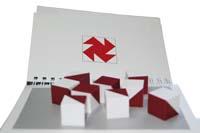But what is intelligence?

The intellectual quotient is linked to a certain way of understanding what intelligence is. In fact, it is considered that intelligence is a stable and monolithic feature that can have several components, but it is unique. Thus, from this concept and the number that supposedly represents that concept, "a single line scale for intelligence was created." This is denounced by paleontologist and writer Stephen Jay Gould in his book “The same easure of man”.
Intellectual quotient scale XX. According to Gould, "one of the greatest incorrect uses of science" of the 20th century. In fact, the person who created these scales, the French psychologist Alfred Binet, created the first tests for another purpose. In 1904 the French Ministry of Education commissioned the development of a series of techniques to identify children who fail in the usual classrooms.
Thus, Binet decided to join a lot of small obligations - linked to problems of daily life. As Gould explains, Binet wanted to highlight three notes to avoid misuse of the tool he had just developed. On the one hand, he pointed out that this is a practical tool that should not be considered an intelligence. On the other hand, he stressed that it is a guide to identify children with learning difficulties and not a tool to graduate normal children. Finally, he noted that specific training of identified children should be affected.
However, Gould says that "they jumped all the notes and turned around all their intentions" when the tests arrived in the United States. In fact, "the Binet scale became the usual written tool for the study of all children."
Critical with intellectual quotient
According to Professor Izaskun Etxebarria of the School of Teachers of the UPV, "today the test, the concept of number is very criticized." To begin with, what is intelligence? "Intelligence is not knowledge, it is not congenital wisdom; intelligence is capacity, and how knowledge is used, how information is encoded, how information is processed, etc. Tests to measure the intellectual quotient, however, focus on questions related to knowledge and the study of some useful skills in academia, leaving aside creativity or problem-solving capabilities."
In fact, one of the most critical things in the tests is its academic character. I Aki Martínez, Counselor of the Colegio Público Virgen Blanca de Huarte and Professor of Psychology at UPNA, has set an example of his life in relation to: "I remember that a child who did the test with me lived on the mountain, in a hippy group. One of the test questions is: What are mailboxes for? In his village there was no mailbox, so at age seven he did not know what the mailboxes were. I could watch it on TV, but I didn't have a TV either."
"Moreover," says Martinez-- "these tests have another limitation: the tool is not in Basque. And so they pass the same test to the children, both of Elizondo and of Tudela. And it's not the same, they don't have the same facility."

However, Martínez is not as critical as Etxebarria with intelligence tests: "We at school have to make decisions constantly and the Administration asks us for a number. Therefore, I think you have to pass the tests rigorously, but interpret them flexibly. For example, last week I passed the test to a child and the result was that I was at the limit of little intelligence. When I spoke with my parents they told me that they are in the process of separation and that they live in a very violent environment. In this situation, the test showed a worse result than the child would get by himself. Therefore, the number obtained in that test is useless to me, we let the time pass and we do it again."
For Martínez, under standardized conditions, tests are useful: "I would get a result if I did the test and surely someone faster than I would get a better result. At least measure something."
Multiple Intelligence Idea
However, both experts believe that IQ tests do not measure a single, monolithic intelligence. Moreover, they do not understand the concept of intelligence. They support another paradigm that is currently in force linked to the concept of intelligence, that is, that there is more than one type of intelligence. "I think these tests measure mostly linguistic and logical-mathematical intelligence," says Etxebarria.
Etxebarria is two of the eight types of intelligence defined by psychologist Howard Gardner. Gardner is one of the references that say that there is more than one intelligence. His theory is called multiple intelligences theory. In 1983 Gardner released it in the book Frames of Mind. He says that intelligence itself is the ability to solve problems or create useful products in more than one culture.
The theory of multiple minds shows that academic intelligence is not enough in life. Etxebarria says: "Reality shows that young people who have been very well at the academic level afterwards, when joining the world of work, have not been successful, or even more, are not happy; or have a painful personal life. On the contrary, some people with average or bad academic results have remained first class professionals, happy and with great contributions to society. Therefore, we cannot think that being an intellectual quotient of 140 will ensure us a successful life, either professionally, personally or socially."
Buletina
Bidali zure helbide elektronikoa eta jaso asteroko buletina zure sarrera-ontzian











